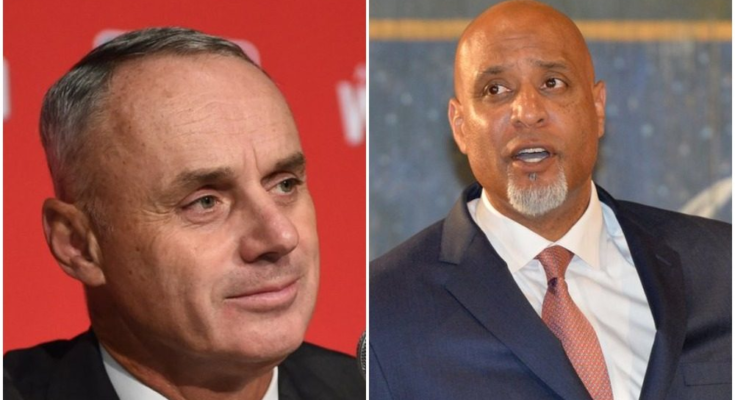12:28pm: The union has received MLB’s new counterproposal, tweets ESPN’s Marly Rivera.
10:43am: The Athletic’s Ken Rosenthal tweets that with the international draft and qualifying offer disagreements now resolved, the league is preparing to make a “full proposal” to the union. As of this writing, MLB had not yet countered the final proposal received by the MLBPA yesterday.
10:29am: Major League Baseball and the Major League Baseball Players Association have reached a provisional agreement regarding the international draft, reports ESPN’s Jeff Passan (Twitter thread). The two parties have set a July 25 deadline to determine the specifics of an international draft that would go into effect beginning in 2024. If a deal on the draft is reached by July 25, the qualifying offer system and the associated draft-pick compensation will be eliminated. If the two sides do not reach a deal on the draft, the qualifying offer system will remain in place — as will the current international amateur free agency structure.
While this is a step shy of an agreement to actually implement the draft itself, it’s nevertheless a major hurdle that has been cleared on the path to the ratification of a new collective bargaining agreement. Discord regarding the league’s desire to trade the elimination of the qualifying offer system for an international draft yesterday derailed talks and led to commissioner Rob Manfred further postponing Opening Day until April 14. The MLBPA’s final proposal to the league included a similar provision to the one agreed upon today, with a Nov. 15 deadline to agree to the draft instead of the newly proposed July 25 deadline.
With the theatrics surrounding the theoretical international draft’s implementation and the qualifying offer system now set to the side, it would appear, ostensibly, that the focus can shift back to the core economic issues that have been the crux of recent negotiations. While the international draft was framed as a sticking point yesterday and garnered a huge portion of the attention, there are still some gaps to bridge on key economic issues such as the competitive balance (luxury) tax thresholds, the newly proposed bonus pool for pre-arbitration players and, to a lesser extent on the league-minimum salary.
As of yesterday afternoon, the MLBPA had dropped its asks on the new CBT thresholds to $232MM in 2022, $235MM in 2023, $240MM in 2024, $245MM in 2025 and $250MM in 2026. The league’s prior proposal included proposed thresholds of $230MM, $232MM, $236MM, $240MM and $242MM over those respective years. In essence, the two parties face respective gaps of $2MM, $3MM, $4MM, $5MM and $8MM in that five-year span.
There’s a wider rift on the pre-arbitration bonus pool, with the union yesterday dropping its proposal to $65MM (presumably with the same $5MM annual increase previously sought). Ownership, meanwhile, has countered with a flat $40MM pool that will not increase at all over the CBA’s five-year term. That $25MM gap is sizable on the surface, though it does boil down to a matter of $833K per team — scarcely more than the new league-minimum salaries that will be going into place.
On that note, MLBTR’s Tim Dierkes reported yesterday that the MLBPA had dropped its proposed league-minimum salary to $710K — narrowing what was a $25K gap to just a $10K gap between MLB’s proposed minimum of $700K. Both parties have agreed that the minimum salary would rise by $70K over the five-year life of the CBA, so the difference at this point rests solely on that small difference in starting point. Of all the issues, this would seem to be far and away the simplest to bridge.
It’s hard not to be encouraged by progress surrounding what had emerged as a major roadblock, but optimism should still be tempered. The gaps on the CBT threshold and, particularly, the bonus pool for pre-arbitration players are still relatively prominent, and there’s no indication yet as to the extent to which MLB will move in its forthcoming proposal. It’s also eminently possible that additional hurdles will arise. Few foresaw the international draft playing such a prominent role prior to this week.
A pair of issues that shouldn’t serve as an obstacle, Dierkes further reports (via Twitter), are on-uniform advertising patches and the Athletics’ revenue-sharing status. Yesterday’s MLBPA proposal agreed to allowing advertising on player uniforms, and the union also agreed to reinstate the Athletics as a revenue-sharing recipient. Oakland did not receive revenue-sharing funds in 2021 or in 2020. They’d seen a reduced share in 2017-19, under the terms of the previous CBA — a penalty levied due to questions about whether the team had sufficiently invested those funds back into the on-field product and whether they’d made their best efforts to secure a new stadium.
Time will tell just what the owners’ latest offer brings, but even tempered optimism is a welcome change from last night’s tenor. Whenever the two parties finally reach an agreement, the floodgates could well open in a hurry. Sports Illustrated’s Tom Verducci said in an appearance on MLB Network this morning that free agency could potentially reopen the same day that an agreement is reached, for instance (Twitter link via MLB Network’s Jon Morosi). And it’s worth noting, too, that The Athletic’s Jayson Stark tweeted this morning that the league still viewed a 162-game season as a possibility.
It’d be premature to say an agreement is nigh, but the breakthrough from yesterday’s most prominent roadblock is a breath of fresh air as an increasingly stagnant lockout reaches its 99th day.


